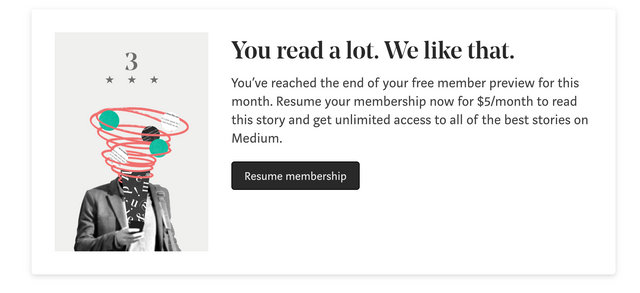A few days ago, I got a question from an online friend of mine, whether to self-host his new blog, or start directly on Medium. I advised him to self-host and use Medium only for content distribution. I have always been pro writer independence, and though I have tried quite a few platforms over the years, none has really withstood the test of time. Medium makes no exception.
There was a time, when I veneered Medium with much respect. It was when it stood for something. It proclaimed no boundaries to freedom of speech, and levels of quality content rarely seen anywhere else. It also set out to avoid advertising in its ugliest form, the one that sticks in your face from the moment you open a Web page
Medium is a new place on the Internet where people share ideas and stories that are longer than 140 characters and not just for friends. It’s designed for little stories that make your day better and manifestos that change the world. It’s used by everyone from professional journalists to amateur cooks. It’s simple, beautiful, collaborative, and it helps you find the right audience for whatever you have to say.
— Ev Williams
Indeed, early Medium did actually look very promising. Clean, nicely-designed Web pages focused on the content and on beautiful imagery that catches the eye. While the early version of the platform was somewhat elitist and exclusive, writers who made it in, gladly shared their writings free of charge. There was a sort of intrinsic motivation, that made early writers double, and triple-check the quality of their writings.
Yet, Medium had grander goals for both its community, and its business. Of course, it is a Silicon Valley startup, so one couldn’t expect anything less. Initially, like most other content businesses, the company heavily experimented with an ad-driven model, especially targeting native advertising and brand publishing. People and companies jumped on board, with the intention to sell their stuff, disguised behind a boastful message, and some beautiful imagery. For a time, Medium turned into a content fan. Whatever you threw at it, got instantly popular, regardless of its quality. In early 2017, this period was claimed to have been a rather “failed experiment”, and the ship got steered in a new direction. One, based on the belief that “people who write and share ideas should be rewarded on their ability to enlighten and inform, not simply their ability to attract a few seconds of attention”. The so-called Membership Program. A noble idea with, IMHO, a sub-optimal execution.

The Membership Program (MP) relies on monthly reader subscriptions, and spreads the money around, to authors who have put their content into a pool of member-only posts. How the money gets distributed exactly is not really clear, but Medium claims it to be based on the amount of engagement members spend on a particular piece of content. The sad fact is that member stories eventually get hidden from non-members, after a certain number of previews. This is the opposite of what Medium originally claimed to have stood for, and to prove it, I decided to become both a member and to add a few of my popular stories to the MP. A month later, despite the fact that one of my previously free articles had amassed more than 100 thousand reads, it still hasn’t received a single cent from the MP, while the engagement I actually care for (replies, comments, discussions, etc) has nearly stalled. I am not sure if this was the “reward” that Ev was talking about. Moreover, I did not see any benefit of being a paid member either.
The MP is just one of the aspects, in which Medium is trying to enclose its community into a silo. For one, despite being the favourite go-to place for most developers nowadays, Medium never really engaged with the developer community, and giving them a chance to build engaging experiences around the platform. There is still only one Medium app, which is not bad, but not something I get to use particularly often. I wanted to build a Medium article reader once, a slick experience that focuses on the text, and not so much on the imagery, one that could potentially even use text-to-speech to read you articles while one the go. I quickly realised that while possible, hacking around Medium’s undocumented internal API did not make much fun.
NOTE: As for what I believe is the future of distributed content monetization, I will rather leave this for a separate post.
Brands also found themselves disengaged, since, as of November last year, custom domains for new users were deprecated.
I would not recommend anyone to use Medium for a new publication without custom domain support. Medium has proven themselves an excessively volatile partner to publications already. Their whims will change again. You need an escape hatch. https://t.co/JFBDFm9nsf
— DHH (@dhh) September 4, 2018
The Bottom Line
Medium is a business, and not a pro-bono community. We should all just get that and not get too caught up, when the company does things in ways to increase profits or increase investor dividends. That’s the primary goal of every business. Medium’s shortcoming is only that by trying to proclaim itself as non-exclusive and available to everyone, it turns into its own walled garden of sorts. Exactly the thing that early Medium claimed to fight against.
Related Reading
This post originally appeared on my blog.

Congratulations @preslavrachev! You have completed the following achievement on the Steem blockchain and have been rewarded with new badge(s) :
Click on the badge to view your Board of Honor.
If you no longer want to receive notifications, reply to this comment with the word
STOPDo not miss the last post from @steemitboard:
Downvoting a post can decrease pending rewards and make it less visible. Common reasons:
Submit